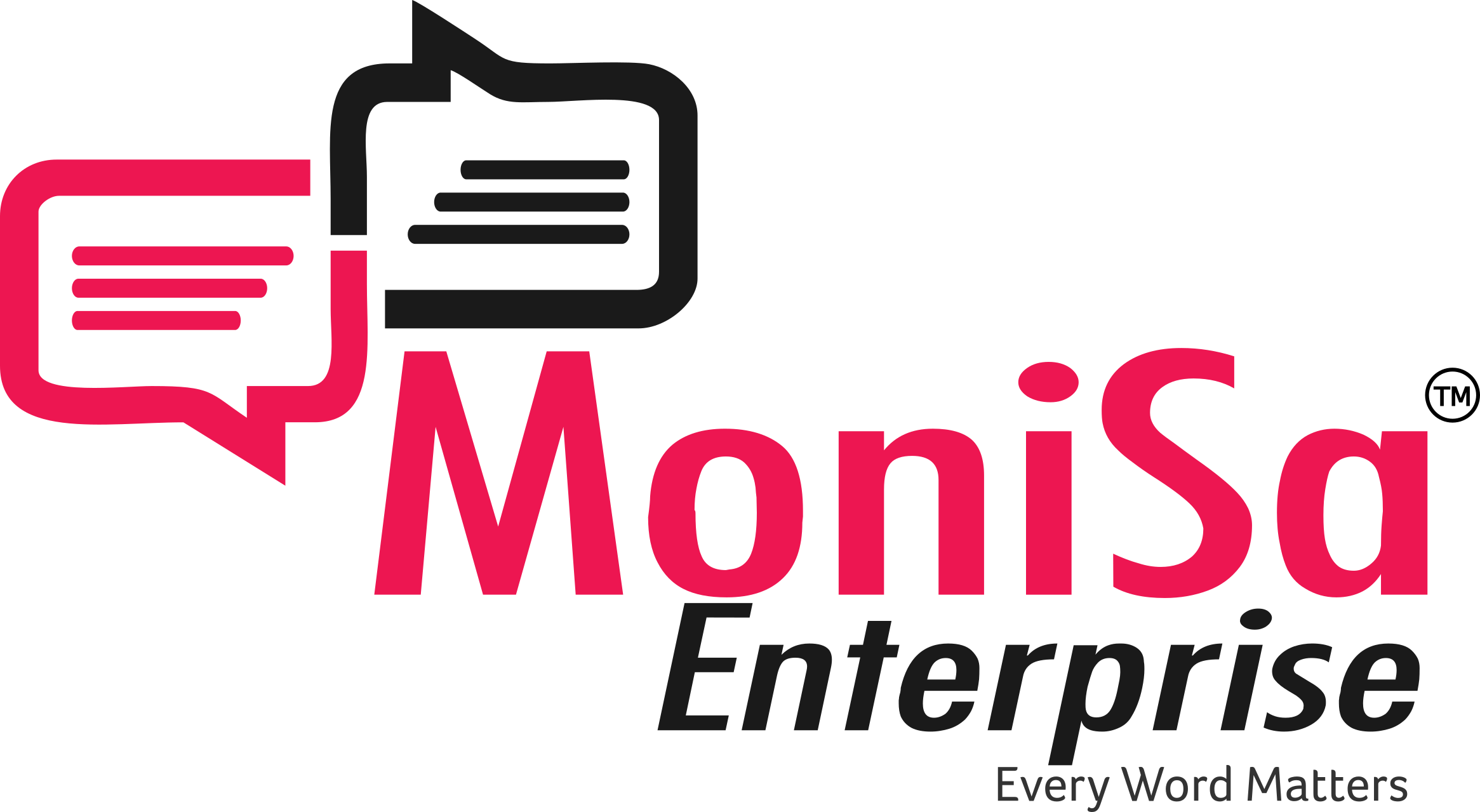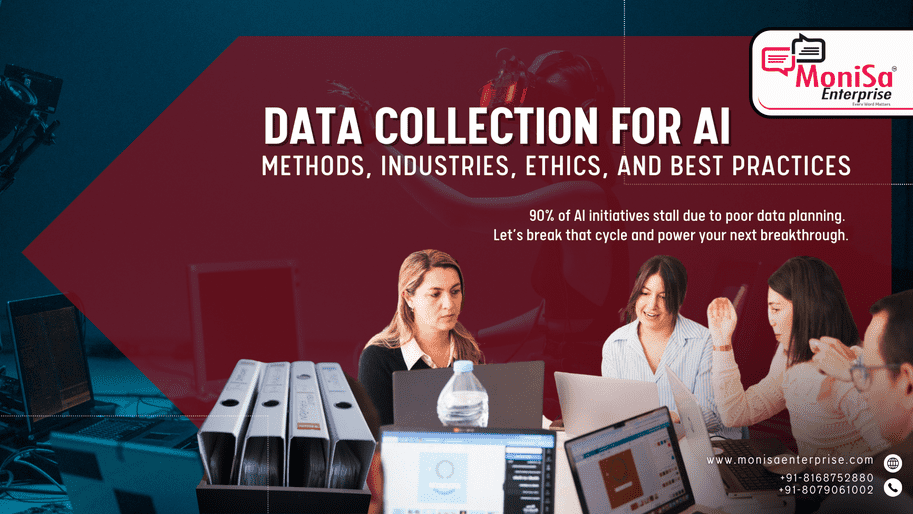Introduction
Table Of Contents
- 1 Introduction
- 2 Why MoniSa Enterprise?
- 3 Key Differentiators:
- 4 What is Data Collection?
- 5 Example outcomes with quality data:
- 6 Who Needs AI Training Data?
- 7 Types of Data Collection for AI
- 8 B) Unstructured Data (Free-text reviews, audio, video)
- 9 C) Semi-Structured Data (JSON logs, XML feeds)
- 10 Data Collection Methods for AI
- 11 Ethical Issues in Data Collection for AI
- 12 Data Collection Policies and Best Practices
- 13 What MoniSa Enterprise Offers
- 14 When you partner with us, you get:
- 15 Client Success Example
- 16 Why Choose MoniSa Enterprise?
- 17 Conclusion
- 18 Frequently Asked Questions
McKinsey found that 90% of AI pilots fizzle out—not because of flawed models, but due to poor data planning. Without high-quality, relevant, and ethically sourced datasets, your AI engine stalls before it ever takes off.
This guide is your roadmap to data success. Whether you’re a Project Manager facing deadline creep, a Talent Acquisition leader exploring AI screening tools, or a Localization Manager handling multilingual NLP, we’ll walk you through proven strategies, industry-specific examples, ethical essentials, and MoniSa Enterprise’s field-tested frameworks.
Why MoniSa Enterprise?
While many vendors offer “data collection,” MoniSa delivers a single-window solution for dataset acquisition, annotation, governance, and localization especially in underrepresented languages.
Key Differentiators:
- 300+ languages, including rare and indigenous (e.g., Zarma, Wolof)
- ISO 27001-certified & GDPR-aligned data handling.
- End-to-end workflows—AI + Human annotation pipelines.
- Real-time transparency via interactive dashboards.
- Scalable from 10 to 1,000 annotators within 2 weeks.
Case in Point: We helped a speech startup train a model in Zarma and Wolof—languages underserved by most providers—reducing time-to-market by 40%.
What is Data Collection?
Data collection (or AI data sourcing) is the process of gathering and preparing inputs—text, images, logs, audio—to train machine learning models. Quality determines everything:
- Model Accuracy – Representative samples prevent edge-case failures.
- Scalability – Clean inputs reduce retraining and errors.
- ROI – Better data slashes costs and accelerates deployment.
Example outcomes with quality data:
- Chatbots that auto-resolve 80% of tickets, deflecting costs by 30%.
- Recommendation engines boosting average order value by 15%.
- Healthcare diagnostics trimming misdiagnosis rates by 25% with image-based AI.
Who Needs AI Training Data?
If you’re steering AI adoption in your org, you need a robust data arsenal.
Here’s where AI data matters most—and how MoniSa has delivered results:
| Industry | Use Case | MoniSa Proof Point |
|---|---|---|
| Healthcare | Annotated radiology scans for early detection | MoniSa helped a medical imaging startup reduce misdiagnoses by 25%, thanks to our certified annotation protocols. |
| Finance | Transaction logs for fraud detection | MoniSa powered a global banks fraud model, improving precision by 12% while cutting labeling time by 30%. |
| Retail & Ecommerce | Behavior data for personalized offers | A global retailer saw a 12% lift in model precision and 40% faster labeling through MoniSas dual‑pass QC. |
| Recruiting & HR Tech | Resume/CV screening & candidate matching | Our custom NER pipelines enabled an HR platform to boost screening accuracy by 18% and scale 5× faster. |
| Localization & L10n | Multilingual corpora for translation models | MoniSas 300+ language pool powered a top streaming services subtitling, reducing turnaround by 50%. |
Types of Data Collection for AI
A) Structured Data (Spreadsheets, SQL tables)
- Pros: Easy to validate, schema-driven
- Cons: Limited nuance
- MoniSa Solution: We integrate structured CRM exports with our custom scripts to normalize schemas and accelerate validation—achieving ≥ 99% data integrity in the first pass.
B) Unstructured Data (Free-text reviews, audio, video)
- Pros: Rich context, real-world language.
- Cons: Harder to clean and annotate.
- MoniSa Solution: Our linguists use a combination of rule-based tagging and ML-assisted workflows to parse raw text/audio, cutting manual cleanup time by 35%.
C) Semi-Structured Data (JSON logs, XML feeds)
- Pros: Flexible, partially normalized
- Cons: Requires custom parsers
- MoniSa Solution: We build bespoke parsing pipelines using open-source tools, then run a dual-layer QC to ensure no schema drift—slashing parsing errors by 28%.
Pro Tip: Blend at least two types to enrich model features—e.g., pair structured CRM fields with free-text support tickets for better context.
Data Collection Methods for AI
| Method | Pros | Cons & Pitfalls | How MoniSa Solves It |
|---|---|---|---|
| Surveys & Questionnaires | Targeted demographics; sentiment insights | Sampling bias; low response rates | MoniSa leverages our vetted global annotator pool and A/B testing frameworks to ensure high response rates and demographic coverage—achieving ≥ 95% response reliability. |
| Web Scraping | Vast, real-time data | Legal/ToS risks; maintenance overhead | We combine IP-masked scraping proxies with our legal team’s ToS compliance checks. Plus, MoniSa in-house scripts auto-detect ToS changes and adapt in real time. |
| APIs & Data Providers | Plug-and-play, large volumes | Costly; may lack domain specificity | MoniSa partnerships with niche data providers fill domain gaps (e.g., medical transcripts, legal filings). We negotiate license terms to optimize cost. |
| Crowdsourcing | Scalable annotation; diverse perspectives | QC challenges; potential annotator bias | MoniSa solves this with a vetted global annotator pool, ensuring QC with dual-pass workflows and ISO-aligned QA. Annotator performance is tracked on real-time dashboards. |
| Sensor/IoT Feeds | Live telemetry for industrial AI | High storage; streaming complexity | Our data engineers build scalable ingestion pipelines (Kafka, AWS Kinesis) with on-the-fly compression and anomaly detection—reducing storage costs by 40%. |
What’s your biggest blocker in data collection? Drop a comment below—we’ve got tips for every roadblock.
Ethical Issues in Data Collection for AI
Privacy & Consent
- Always obtain explicit opt-ins and maintain detailed audit trails.
- MoniSa’s Approach: GDPR-aligned consent management tools, ISO 27001-certified encryption at rest and in transit, and regular third-party security audits ensure zero PII leaks.
Bias & Fairness
- Proactively document demographic splits; counter-sample underrepresented groups.
- MoniSa’s Approach: We implement stratified sampling and use fairness dashboards to track demographic splits in real time. For example, in a finance dataset, we ensured equal representation across five income brackets—reducing model bias by 22%.
Transparency & Lineage
- Version control your datasets and publish lineage docs.
- MoniSa’s Approach: Every dataset is tagged with immutable metadata (collection date, schema version, annotator IDs). Clients can trace every datapoint through our Git-based workflows (DVC integration).
Security & Compliance
- Encrypt PII at rest and in transit; enforce role-based access.
- MoniSa’s Approach: ISO 27001-certified data centers, AES-256 encryption, and SOC 2 Type II audits. For healthcare clients, we enforce HIPAA-level controls; for finance, PCI-DSS alignment.
One data breach can cost you millions—and your brand’s hard-earned credibility. MoniSa’s certified protocols and encryption practices mean you’re covered.
Data Collection Policies and Best Practices
Regulatory Compliance
- GDPR, CCPA: Design data flows with “right to be forgotten” and consent loggers.
- MoniSa’s Advantage: Our legal and compliance teams maintain a regulatory matrix (GDPR, CCPA, LGPD, HIPAA). Clients automatically receive quarterly compliance reports.
Governance Framework
- Appoint Data Stewards; run quarterly audits.
- MoniSa’s Advantage: We assign a dedicated Data Steward to each project, running automated QC checks every 24 hours.
Quality Assurance (QA)
- Dual-review annotation; aim for ≥ 99% accuracy.
- MoniSa’s Advantage: Dual-layer QC with blind-reviews, plus real-time dashboards that flag disagreements above 2%—keeping error rates under 1%.
Versioning & Storage
- Immutable backups; tag by date, schema, and project stage.
- MoniSa’s Advantage: All datasets live in an S3-backed, version-controlled environment—enabling instant rollback to any snapshot.
Automation & CI/CD
- Integrate dataset validation into your MLOps pipeline—fail fast, fix faster.
- MoniSa’s Advantage: Our engineers set up automated validation scripts (based on Great Expectations) that run on every data commit, cutting manual review by 50%.
Insider Hack: Treat data like code—leverage git-based workflows (e.g., DVC, Pachyderm) for seamless collaboration.
What MoniSa Enterprise Offers
Many teams struggle with fragmented workflows across multiple vendors. MoniSa unifies everything—from multilingual collection and domain-specific annotation to legal compliance and delivery—under one roof.
When you partner with us, you get:
- Multilingual Collection: 300+ languages, including under-resourced ones.
- Custom Annotation: NER, sentiment, speech-to-text, image labeling.
- Synthetic Data Generation: Reduces labeling effort by up to 30%.
- Scalable Team Deployment: 10 to 1,000 annotators in under 2 weeks.
- Transparent Dashboards: See QC metrics, costs, and timelines live.
Client Success Example
A global retailer slashed labeling time by 40% and boosted model precision by 12% thanks to our dual-layer QC workflows and real-time monitoring.
Why Choose MoniSa Enterprise?
- Ethical by Design: GDPR-compliant, ISO 27001-certified, and zero-tolerance for PII leaks.
- Rapid Scalability: Scale from 10 to 1,000 annotators in under 2 weeks without firefighting.
- Transparent Pricing: Enterprise tiers align with your P&L—no hidden fees.
- Actionable Dashboards: See project status, cost burn, and quality metrics in real time.
Don’t let patchy data derail your Q4 AI roll-out. Secure your competitive edge now.
Conclusion
You’ve got the 360° blueprint on AI data collection—from theory and ethics to hands-on tactics. Ready to fuel your next AI breakthrough?
Your Action Plan:
Audit your current datasets against this checklist.
Identify your top 3 gaps (e.g., language coverage, bias, volume).
Book a strategy call with MoniSa Enterprise to map your data roadmap.
Every day you delay, your competitors’ models get smarter. Don’t fall behind. Book a strategy call with MoniSa—start your data acceleration now.
Let’s Chat: What’s the one data challenge you’re tackling next? Share below!
Frequently Asked Questions
What is the difference between AI training data and raw data?
Raw data is unstructured and unprocessed, while AI training data is cleaned, labeled, and formatted to be directly consumable by machine learning models.
How can I ensure my AI data is diverse and unbiased?
To ensure diversity and reduce bias, combine data from varied sources, audit demographic distributions, and use synthetic data to fill representation gaps. MoniSa Enterprise offers real-time fairness dashboards to track and balance these splits.
Does MoniSa Enterprise handle data privacy compliance?
Absolutely. MoniSa Enterprise is fully GDPR-compliant and ISO 27001-certified. We also ensure consent management and use encrypted PII protocols to secure your data at every stage.
Can I get industry-specific AI datasets from MoniSa Enterprise?
Yes. Whether you’re in healthcare, finance, automotive, or retail, our vertical-specific datasets are designed to boost model accuracy and reduce time-to-market.


